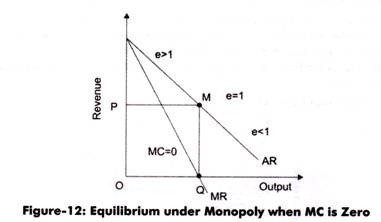In certain situations, it may happen that MC is zero, which implies that the cost of production is zero. For example, cost of production of spring water is zero. However, the monopolist will set its price to earn profit.
Figure-12 shows the monopoly equilibrium when MC is zero:
In Figure-12, AR is the average revenue curve and MR is the marginal revenue curve. In such a case, the total cost is zero; therefore, AR and MR are also zero. As shown in Figure-12, equilibrium position is achieved at the point where MR equals zero that is at output OQ and price P.We can see that point M is the mid-point of AR curve, where elasticity of demand is unity. Therefore, when MC = 0, the equilibrium of the monopolist is established at the output (OQ) where elasticity of demand is unity.
ADVERTISEMENTS:
Short-Run and Long-Run View under Monopoly:
Till now, we have discussed monopoly equilibrium without taking into consideration the short-run and long- run period. This is because there is not so much difference under short run and long run analysis in monopoly.
In the short run, the monopolist should make sure that the price should not go below Average Variable Cost (AVC). The equilibrium under monopoly in long-run is same as in short-run. However, in long-run, the monopolist can expand the size of its plants according to demand. The adjustment is done to make MR equal to the long run MC.
In the long-run, under perfect competition, the equilibrium position is attained by entry or exit of the organizations. In monopoly, the entry of new organizations is restricted.
The monopolist may hold some patents or copyright that limits the entry of other players in the market. When a monopolist incurs losses, he/she may exit the business. On the other hand, if profits are earned, then he/she may increase the plant size to gain more profit.
